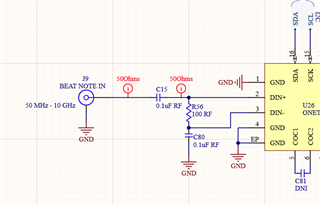Other Parts Discussed in Thread: ONET1191P
I have a singled-ended SMA source going into a ONET8501P as shown below. I then take the output and send one of the differential outputs to a AC-coupled 50-terminnated monitor and the other end goes to another ONET8501P with the same input as the first one (AC coupled, 50Ohm terminated). I'm observing that I need way more input signal strength than expected at higher frequencies. If I put in a 1 GHz clock input, I can look measure the signal strength needed to trip the LOS output, and they match up right where I expect them to. (If LOS is configured to trip at 45mV p2p, it trips when I input -17dBm signal on the SMA input, as expected). However, when I increase my frequency to 3 GHz, I need -12dBm (an extra 5dB) and by 6 GHz, I need an extra 13dB! I see almost identical behavior when measuring the input power necessary to maximum the output (where the 40dB gain starts to clamp). Interestingly, when inputting a strong signal so the output is at full strength (300mV), I see the similar behavior where at lower frequencies, I get the expected 300mV output, but by 6GHz the output is almost 13dB lower than expected. Finally, I connect the output of the 2nd stage of gain to a frequency counter is test when I start miscounting my input signal, and it shows the same behavior where at lower frequencies, I need only a -32dBm signal to get accurate counts, but by 6 GHz, I need a 10dB stronger signal.
Now, all of this sounds consistent with a PCB / cabling that is strongly attenuating at high frequency. However, my traces are all short (2cm max) and impedance matched and I've calibrated out my small loss from cables going to my test equipment. Additionally, I have a nearly identical circuit using the ONET1191P which has almost identical performance specs, and with this chip it works fine up to 10 GHz. Also, I find that when I increase the output strength from 300mV to 600mV or 900mV, my data gets much worse and I need much higher (10 to 20dB more) signals to get accurate counts.
The biggest difference that I can see between the ONET8501P and the ONET1191P is that the ONET1191P gives access mid-point of the 100 input termination so you can do a more standard singled-ended 50 termination to one input and just AC-terminate the other input. Since the ONET8501P does have give access to that pin, I used the circuit below to 50 terminate my singled ended source. Could that be giving me problems at higher frequency? And why does the output signal strength affect performance, especially where a stronger output power gives worse performance? At 900mV output, my 3.3V power rail isn't sagging.
In all my tests, the input filter on the ONET8501P is set at 12 GHz. I tried disabling the offset cancellation and manually setting the offset, but that made no difference (just slightly worse performance overall)
Any ideas on what could be going on or what to test would be appreciated. Thanks!


